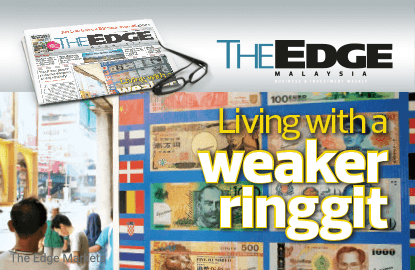
KUALA LUMPUR: On Friday, trading hours ended with the ringgit at 4.4183 against the greenback, and Barclays expects the ringgit to weaken to as much as 5.0 by year-end, according to Bloomberg data.
The most bearish forecaster still expects the local note to average 4.70 next year, wrote The Edge Malaysia editor Cindy Yeap in the publication’s cover story 'Living with a Weaker Ringgit' for the week of Nov 21-Nov 27, 2016.
While that's no change from late-September, mean and median expectations have risen by 8-12 sen for 2017.
One can argue the view may be too bearish but the fact remains that foreigners are pulling their money out from emerging markets, including Malaysia, on renewed prospects of a US interest rate hike early that could take place as early as next month.
The ringgit isn’t the only one faring badly after Donald Trump’s surprise win at the US presidential election. But part of last week’s slide was due to Bank Negara Malaysia’s abrupt move on Nov 11, when it directed locally-licensed banks to ignore offshore ringgit rates when setting their ringgit reference rate and demanded that foreign banks provide written commitment to not trade ringgit non-deliverable forwards.
The directive raised not just questions about the central bank’s reserve adequacy but also concerns that Malaysia might impose capital controls as it did in 1998, when it pegged the ringgit at 3.80 to the US dollar to combat currency speculators and protect the local economy.
BNM has since come out to assure that reserves remain at “comfortable” levels and that the ringgit, being a non-internationalised currency, is “one protection that would already prevent the kind of destabilising forex market” witnessed in 1998.
Meanwhile, the situation now is such that Malaysia faces "monetary policy challenges with a weaker currency", on the reversal of the large capital inflows into the country seen between late-2009 and early 2013.
Straight up, a weaker ringgit would make imported medicine more expensive and reduce the number of Malaysians who can afford to seek higher education outside Malaysia.
A rough calculation, the weekly wrote, shows a four-year undergraduate course in Australia today can be double that seen in 1986, no thank to higher cost of living and yes, the weaker ringgit against the Aussie dollar. It was 1.73 against the AUD in 1986, versus 3.29 today.
The situation is no better for those looking to study in Singapore, Canada, the US or the UK, where universities are ranked higher than Malaysia's own public universities.
The Singapore dollar’s strength against the ringgit, paper wrote, is one reason why Malaysians who studied in Singapore and are working there are finding it hard to return here, where they would face higher personal income tax. In 1976, one needed RM1.03 to buy a Singapore dollar. Ten years on, one needed RM1.80. In 1997, it was RM2.30. Today, it is RM3.10.
“The divergence in the value of the ringgit versus the Singapore dollar can be explained by the higher income and productivity levels in Singapore. It has been able to move up the value chain, producing higher-value goods and services that are skills and knowledge-intensive, leading to a high-income, high-wage economy as well as a strong currency that reflects its international purchasing power,” said Dr Yeah Kim Leng, economics professor at Sunway University Business School and former group chief economist at credit rating agency, RAM Holdings Bhd.
And as competition ratchets up, particularly from lower-cost producer countries, Malaysia can’t rely on its cheap currency to boost exports and economic growth forever. The way forward is to innovate and increase productivity to move up the value chain, said RHB Research Institute executive chairman and chief economist Lim Chee Sing.
Let's not forget also that not all local exporters enjoy the “very short-term” benefit of a weaker ringgit. “For manufacturers relying on imported inputs, the uncertain direction of a currency very often creates fears of product mispricing and could cause them to hold back production and investment, albeit temporarily,” Lim said.
Julia Goh, economist at UOB Bank Malaysia, told the weekly: “Businesses find it hard to manage when currencies continue to fluctuate rapidly. I think we are at the point in our economic cycle of promoting more investment and higher value-added activities, which will see higher dependence on imports. As such, the weaker currency does not help.”
To Yeah, “The strength of a currency reflects not only the country’s economic fundamentals — such as income, productivity, growth, inflation and current account balance — but also ‘soft factors’ that influence investor confidence and market sentiments, such as the quality of institutions, macroeconomic management capabilities and soundness of policies."
True, currencies can be misaligned by short-term sentiment and confidence issues but it should reflect an economy’s fundamentals in the long run, the weekly noted.
So how does the market expect the ringgit to move against the greenback next? Is 4.0 against the US dollar the new norm we will have to live with? What can the country do to ease the impact of that on its people? And can a non-internationalised ringgit still come under speculative attack?
Grab a copy of The Edge Malaysia today to find out more.
P/S: The Edge Malaysia can also be downloaded from Apple's AppStore and Androids' Google Play.
Save by subscribing to us for your print and/or digital copy.
P/S: The Edge is also available on Apple's AppStore and Androids' Google Play.